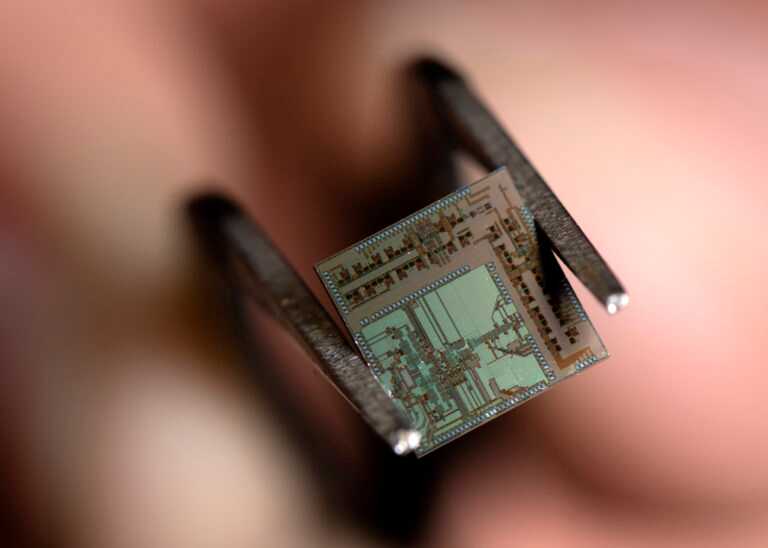By Nitan Dahad, European correspondent for EE Times
A group of researchers have created a wireless transceiver chip enabling transmission of signals beyond 100 GHz at lower cost and energy consumption than current systems. Those frequencies are far higher than anything considered for 5G cellular communications, meriting the researchers’ description of the device as “beyond 5G.”
Their ultimate goal is more ambitious than merely going beyond 5G; it’s to create a technological path that will enable wireless systems to compete with fiber optics.
The team from the Nanoscale Communication Integrated Circuits (NCIC) Labs at the University of California, Irvine (UCI), have created a 4.4-mm2 chip capable of processing digital signals significantly faster and being more energy-efficient than anything available today. It does this by utilizing a unique digital-analog architecture that significantly relaxes digital processing requirements by modulating the digital bits in the analog and radio-frequency domains. The researchers claimed that in using the approach, they’ve overcome the limitations of Moore’s Law.
They fabricated the single-channel 115- to 135-GHz receiver prototype in a 55-nm SiGe BiCMOS process. The device was measured to have a wireless data rate of 36 Gb/s across a gap of 30 cm. On the receive side, the 8PSK signal is demodulated on-chip at a bit-error rate (BER) of 1e−6 . The measured receiver sensitivity at this BER is −41.28 dBm. The prototype occupies 2.5 × 3.5 mm² of die area, including pads and test circuits (2.5-mm² active area). It consumes a total DC power of 200.25 mW. The maximum conversion gain was 32 dB and minimum noise figure was 10.3 dB.

NCIC’s single-channel 115- to 135-GHz receiver prototype is fabricated in a 55-nm SiGe BiCMOS process, measuring a wireless data rate of 36 Gb/s at 30-cm distance. (Image: UCI)
Their innovation is outlined in a paper, “A 115-135-GHz 8PSK Receiver Using Multi-Phase RF-Correlation-Based Direct-Demodulation Method ,” published recently in the IEEE Journal of Solid-State Circuits. In it, they present the theory, design, and implementation of the receiver. The output of the RF-to-bits receiver architecture is demodulated bits, obviating the need for power-hungry high-speed-resolution data converters.
The senior author, Payam Heydari, who is NCIC Labs director and UCI professor of electrical engineering and computer science, said that academic researchers and communications circuit engineers have long wanted to know if wireless systems are capable of the high performance and speeds of fiber-optic networks. “If such a possibility could come to fruition, it would transform the telecommunications industry because wireless infrastructure brings about many advantages over wired systems.”
He said that his group’s transceiver chip, which they have labelled “Beyond 5G,” leapfrogs over the 5G wireless standard and takes them into the realms of the 6G standard, which is expected to work at 100 GHz and above. The research group said that with the Federal Communications Commission recently opening up new frequency bands above 100 GHz, their new transceiver is the first to provide end-to-end capabilities in this part of the spectrum.
Overcoming Moore’s Law limitations
According to Heydari, changing frequencies of signals through modulation and demodulation in transceivers has traditionally been done via digital processing, but in recent years, integrated circuit engineers have begun to see the physical limitations of this method.
“Moore’s Law says we should be able to increase the speed of transistors — such as those you would find in transmitters and receivers — by decreasing their size, but that’s not the case anymore,” he said. “You cannot break electrons in two, so we have approached the levels that are governed by the physics of semiconductor devices.” To get around this problem, NCIC Labs developed the technique to modulate the digital bits in the analog and RF domains, which enables a chip layout at a lower cost and lower energy consumption.
The team said that the technology combined with phased-array systems — which use multiple antennas to steer beams — facilitates a number of disruptive applications in wireless data transfer and communication. This will eliminate the need for miles of fiber-optic cables in data centers, so data farm operators can do ultra-fast wireless transfer and save considerable money on hardware, cooling, and power.
TowerJazz and STMicroelectronics provided semiconductor fabrication services to support this research project.
This article originally appeared on EE Times .
Advertisement
Learn more about Electronic Products Magazine





